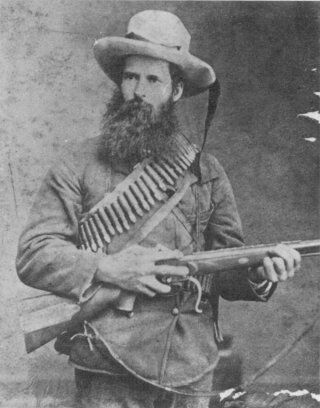

 The South African
The South African
The rifles used by both forces were very similar in manufacture, sighting, calibre, weight, and ammunition. The British were issued with the Martini-Henry, and the Boers mainly used the Westley Richards, falling-block, breech-loader.
The Boer victory in this war can largely be attributed to their prowess in handling their rifles, and to superior tactics employing fire and movement.
Burgher Law had been in force in the Cape since the early days of the settlement in South Africa. This law stipulated that every male from 16 to 60 years of age had to supply himself with a horse, saddle and bridle, a musket, 30 lead balls, and 30 charges of black powder, as well as three days’ rations, and he had to be ready for military service at a moment’s notice.
The Boers learned to shoot from an early age. They were keen hunters, wild game was plentiful, and they shot daily for the pot. When the occasion arose they were able to defend their isolated homesteads from marauding Black tribesmen. Contests were held from time to time to improve their marksmanship and they became excellent shots even while on horseback.
The British soldier on the other hand was never a good shot, being trained in the main to use mass volleys. There is therefore no doubt that any slight advantage the British might have had from their overall issue of the Mk III Martini Henry 0.450” breech-loading rifle was outweighed by Boer markmanship.
Rifle
The characteristics of the weapon were:
| Overall length: | 49,5 inches (125,2 cm) |
| Barrel length: | 33,2 inches (84,3 cm) |
| Weight: | 8,5 - 9,0 lb (3,84 kg - 4,08 kg) depending on type of timber used in stock. |
| Muzzle velocity: | 1 350 feet (411 m) per second |
| Sights: | 100 - 1 450 yds (90 - 1 326 m) |
The Martini-Henry Rifle fired the 0,577”/0,450” cartridge which by 1881 was a drawn-brass, centre-fire cartridge with a paper-patched lead bullet of 450 grammes. The propellant was 85 grammes of black powder.
The bayonet used with the Mark III rifle was the pattern 1876 triangular socket bayonet which was secured to the barrel by means of a locking ring. The length of the bayonet was 25.25 inches (64 cm). The total length of the rifle with fixed bayonet was 69 inches (1,75 m), a prodigious length indeed.
Cavalry and artillery units of the time were issued with a Martini-Henry Carbine which was shorter and lighter than the rifle. There was however no cavalry as such engaged at the three battles of Laingsnek, Schuinshoogte, and Majuba in January and February 1881, although the mounted troops that participated at Laingsnek and Schuinshoogte did include a few members of the King’s Dragoon Guards who were probably equipped with the carbine. The remainder of the mounted troops, made up largely of members of the 58th Regiment and 3/60th Rifles, are depicted in most illustrations as carrying the standard rifle.
The officers probably had the centre-fire double-action 0.45 inch Webley revolver although some officers may still have had the Adams revolver which was an earlier issue. They were also equipped with a regulation sword.
The following weapons were available in South Africa in 1880, and are mentioned in the various catalogues issued by the dealers at that time:

Typical Boer carrying
.500/.450 Westley Richards
falling block ‘Free State Martini’
The Boer was not unaccustomed to storming hills, as seen from his attack on the Basutos, and in the Sekukuni Wars, such attacks being carried out in mountainous terrain.
The tactic employed at Majuba was to deploy the older, less fit, and less agile Boers, who were often the more experienced and better shots, under cover at the foot of Majuba Hill. These kept up a sustained and deadly fire directed at the crest line, shooting at any British head that showed. The assault parties were the younger men, who made rapid progress upward, with little hindrance from British fire above. Flanking fire from the two main Boer assault groups covered each other in turn as they moved upwards, zig-zagging from cover to cover.
The height of Majuba is approximately 2 000 ft (610 m) and this distance was easily reached by the Boers providing covering fire at the foot of the hill, using their rifles which had an effective range of 1 000 yards (914 m).
Joseph H. Lehmann in his book ‘The First Boer War’ (Jonathan Cape - London 1972), page 242, states: ‘Employing chiefly the very fine breech-loading Westley Richards - calibre 45; paper cartridge; percussion-cap replaced on the nipple manually - they made it exceedingly dangerous for the British to expose themselves on the skyline’.
He is referring to the assault parties using the Westley Richards capping breech-loader. A thorough search has not turned up one photograph of a Boer at Majuba using the ‘Monkey Tail’ Westley Richards capping breech-loader rifle. Some must have been used but most photographs show the Westley Richards falling-block rifle breech-loader, which used a number two cartridge of calibre 0,45/0,577 inch bullet.
The British did not, therefore, enjoy quite the advantage in firearms and firepower that so many historians have claimed during the past hundred years. In fact the Boers had the advantage because they were second to none in handling and firing their weapons and they fired and re-loaded with such rapidity that the British were often misled into thinking that there were three or four times as many as there actually were.
References:
Return to Journal Index OR Society's Home page
South African Military History Society / scribe@samilitaryhistory.org